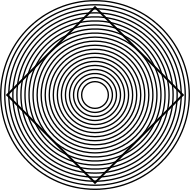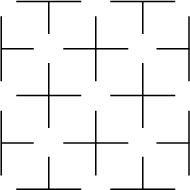Ehrenstein illusion
The Ehrenstein illusion is an optical illusion studied by the German psychologist Walter Ehrenstein (1899 – 1961) in which the sides of a square placed inside a pattern of concentric circles take an apparent curved shape (Figure 1).[1][2]
 Ehrenstein illusion (1)
Ehrenstein illusion (1) Illusion (2)
Illusion (2) Illusion (3); adding a circle (bottom) destroys the illusion of a bright central disk.
Illusion (3); adding a circle (bottom) destroys the illusion of a bright central disk.
Sometimes the name "Ehrenstein" is associated with one of the illusory contour figures (Figure 2).[3][4][5] The ends of the dark segments produce the illusion of circles. The apparent figures have the same color as the background, but appear brighter. A similar effect is obtained in the Kanizsa triangle.
References
| Wikimedia Commons has media related to Illusory contours. |
- ↑ A catalogue of illusions at Ritsumeikan University
- ↑ W. Ehrenstein (1925). "Versuche über die Beziehungen zwischen Bewegungs- und Gestaltwahrnehmung" [Experiments on the Relationships Between the Perception of Motion and of Gestalt]. Zeitschrift für Psychologie. 96: 305&mdash, 352.
- ↑ Ehrenstein illusion at Scholarpedia
- ↑ W. Ehrenstein (1941). "Über Abwandlungen der L. Hermannschen Helligkeitserscheinung". Zeitschrift für Psychologie. 150: 83&mdash, 91.
- ↑ W. Ehrenstein (1954). Probleme der ganzheitspsychologischen Wahrnehmungslehre. Leipzig: Barth.
This article is issued from
Wikipedia.
The text is licensed under Creative Commons - Attribution - Sharealike.
Additional terms may apply for the media files.